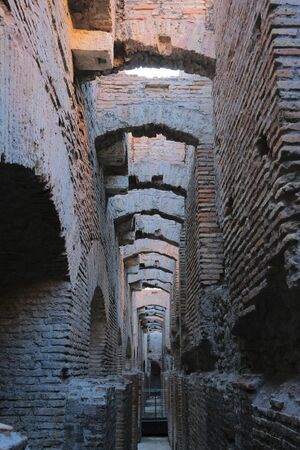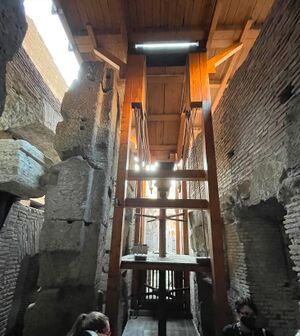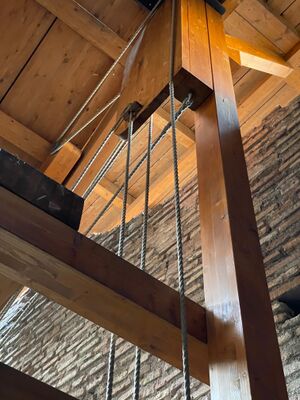Difference between revisions of "Reconstructing the Past"
(Created page with "=== The stage machinery of the Colosseum === ''The Colosseum in Rome once had many stage lifts, able to bring people, scenery and animals up through the floor of the arena....") |
|||
| (One intermediate revision by the same user not shown) | |||
| Line 2: | Line 2: | ||
''The Colosseum in Rome once had many stage lifts, able to bring people, scenery and animals up through the floor of the arena. In 2014, one of the lifts was reconstructed, demonstrating the skilful techniques used by the Romans nearly 2000 years ago.'' | ''The Colosseum in Rome once had many stage lifts, able to bring people, scenery and animals up through the floor of the arena. In 2014, one of the lifts was reconstructed, demonstrating the skilful techniques used by the Romans nearly 2000 years ago.'' | ||
| + | |||
| + | [[File:IO2 J.01 03.jpg|thumb|left|The under-stage passages where the stage elevators were located.]] | ||
The Roman amphitheatres were elliptical buildings used for a variety of spectacles including gladiatorial games – fights between gladiators and between gladiators and animals. Perhaps the most famous amphitheatre is the [[Item:Q615|Colosseum]] in Rome (Q615). At the centre of the amphitheatre is a flat elliptical area called the arena. All around it is the ''cavea'', the brickwork tiers, where spectators took their seats. These buildings had foundations of opus ''caementicium'', pebbles or rubble bound with lime mortar, and above that masonry, including stone and marble, reaching heights of around 50 metres. The outer perimeter of the amphitheatre, with arches, was adorned with columns and pilasters, with various decorations and statues, so as to give it a monumental appearance. The entire amphitheatre had a huge ''velarium'' – a canvas roof – for protection from the sun, stretched by ropes and driven by winches. | The Roman amphitheatres were elliptical buildings used for a variety of spectacles including gladiatorial games – fights between gladiators and between gladiators and animals. Perhaps the most famous amphitheatre is the [[Item:Q615|Colosseum]] in Rome (Q615). At the centre of the amphitheatre is a flat elliptical area called the arena. All around it is the ''cavea'', the brickwork tiers, where spectators took their seats. These buildings had foundations of opus ''caementicium'', pebbles or rubble bound with lime mortar, and above that masonry, including stone and marble, reaching heights of around 50 metres. The outer perimeter of the amphitheatre, with arches, was adorned with columns and pilasters, with various decorations and statues, so as to give it a monumental appearance. The entire amphitheatre had a huge ''velarium'' – a canvas roof – for protection from the sun, stretched by ropes and driven by winches. | ||
| − | The games and fights took place on the arena’s wooden deck, covered with sand. On the sides were openings with gratings for men and animals to enter. The fights were bloody | + | The games and fights took place on the arena’s wooden deck, covered with sand. On the sides were openings with gratings for men and animals to enter. The fights were bloody and violent. The audience was constantly amazed by various tricks, scenic effects and spectacular gimmicks to thrill them. Dozens of beasts were raised simultaneously on the arena, lifted by hoists invisible to the public: leopards, bears, wolves, ostriches and deer were amongst the animals used, taken from all corners of the empire – the highlight of the spectacle. |
| + | |||
| + | The system of lifts installed in the Colosseum changed over time. The Colosseum first opened in 80 or 81CE, initially with 28 lifts around the perimeter, with another 20 inclined planes in the centre, that could bring large scenographic elements and people into the arena. After a disastrous fire in 217CE, the inclined planes for the scenery were reconstructed, while the hoists for the animals were increased to 60 and were placed in the corridors under the central part of the arena. The lifts were human-powered devices, so hundreds of people were required in the underground area of the Colosseum just to operate the hoists, as well as the gladiators and people to handle the animals. | ||
| − | + | [[File:IO2 J.01 05.jpg|thumb|The reconstructed stage elevator]] | |
| + | [[File:IO2 J.01 06.jpg|thumb|The reconstructed stage elevator]] | ||
There are no drawings or detailed records of the lifts. What little that is known about them comes from the careful examination of the surviving stonework of the walls in the under-stage – grooves and cut-outs in the masonry show where the wooden structures of the lifts fitted, while some of the metal sockets where the poles of winches ran are still present. To gain a greater understanding of the construction of the lifts, and to be able to demonstrate how they worked to the public, one of the 28 hoists has been reconstructed. The Project was a collaboration between the S''oprintendenza Speciale per il Colosseo, il Museo Nazionale Romano e l'Area Archeologica di Roma'' (Special Superintendence for the Colosseum, the National Roman Museum and the Archaeological Area of Rome) and Providence Pictures, which in 2013 proposed the reconstruction of a lift for the making of the documentary ''Colosseum: Roman Death Trap''. | There are no drawings or detailed records of the lifts. What little that is known about them comes from the careful examination of the surviving stonework of the walls in the under-stage – grooves and cut-outs in the masonry show where the wooden structures of the lifts fitted, while some of the metal sockets where the poles of winches ran are still present. To gain a greater understanding of the construction of the lifts, and to be able to demonstrate how they worked to the public, one of the 28 hoists has been reconstructed. The Project was a collaboration between the S''oprintendenza Speciale per il Colosseo, il Museo Nazionale Romano e l'Area Archeologica di Roma'' (Special Superintendence for the Colosseum, the National Roman Museum and the Archaeological Area of Rome) and Providence Pictures, which in 2013 proposed the reconstruction of a lift for the making of the documentary ''Colosseum: Roman Death Trap''. | ||
Latest revision as of 15:44, 13 February 2023
The stage machinery of the Colosseum
The Colosseum in Rome once had many stage lifts, able to bring people, scenery and animals up through the floor of the arena. In 2014, one of the lifts was reconstructed, demonstrating the skilful techniques used by the Romans nearly 2000 years ago.
The Roman amphitheatres were elliptical buildings used for a variety of spectacles including gladiatorial games – fights between gladiators and between gladiators and animals. Perhaps the most famous amphitheatre is the Colosseum in Rome (Q615). At the centre of the amphitheatre is a flat elliptical area called the arena. All around it is the cavea, the brickwork tiers, where spectators took their seats. These buildings had foundations of opus caementicium, pebbles or rubble bound with lime mortar, and above that masonry, including stone and marble, reaching heights of around 50 metres. The outer perimeter of the amphitheatre, with arches, was adorned with columns and pilasters, with various decorations and statues, so as to give it a monumental appearance. The entire amphitheatre had a huge velarium – a canvas roof – for protection from the sun, stretched by ropes and driven by winches.
The games and fights took place on the arena’s wooden deck, covered with sand. On the sides were openings with gratings for men and animals to enter. The fights were bloody and violent. The audience was constantly amazed by various tricks, scenic effects and spectacular gimmicks to thrill them. Dozens of beasts were raised simultaneously on the arena, lifted by hoists invisible to the public: leopards, bears, wolves, ostriches and deer were amongst the animals used, taken from all corners of the empire – the highlight of the spectacle.
The system of lifts installed in the Colosseum changed over time. The Colosseum first opened in 80 or 81CE, initially with 28 lifts around the perimeter, with another 20 inclined planes in the centre, that could bring large scenographic elements and people into the arena. After a disastrous fire in 217CE, the inclined planes for the scenery were reconstructed, while the hoists for the animals were increased to 60 and were placed in the corridors under the central part of the arena. The lifts were human-powered devices, so hundreds of people were required in the underground area of the Colosseum just to operate the hoists, as well as the gladiators and people to handle the animals.
There are no drawings or detailed records of the lifts. What little that is known about them comes from the careful examination of the surviving stonework of the walls in the under-stage – grooves and cut-outs in the masonry show where the wooden structures of the lifts fitted, while some of the metal sockets where the poles of winches ran are still present. To gain a greater understanding of the construction of the lifts, and to be able to demonstrate how they worked to the public, one of the 28 hoists has been reconstructed. The Project was a collaboration between the Soprintendenza Speciale per il Colosseo, il Museo Nazionale Romano e l'Area Archeologica di Roma (Special Superintendence for the Colosseum, the National Roman Museum and the Archaeological Area of Rome) and Providence Pictures, which in 2013 proposed the reconstruction of a lift for the making of the documentary Colosseum: Roman Death Trap.
The design for the reproduction lift was based on careful examination of the surviving stonework, to ensure the lift would fit in exactly the same way the originals did. The mechanism is not just a simple lift – as well as lifting a cage that can take a large wild animal, it also has to lower a section of the stage floor at an angle to make a ramp, and then open the cage door so that the animal’s only way out is up the ramp and into the arena. Some of the design was worked out at the Museo delle Navi Romane (Museum of the Roman Ships) in Nemi, where historic techniques using ball bearings, pulleys, hemp ropes, winches and hoists can be seen, since these were the solutions to the problems of transmitting motion, lifting loads and reducing friction forces that the Romans had available. A 1:4 model of the lift was constructed, so that the planned mechanism could be checked and refined.
In May 2014, the full-size lift was carried over the walls of the Colosseum, lowered into the centre of the arena and placed in its position between the still-existing walls of the under-stage by a huge, modern crane. The cage measures 180cm by 140cm, with an internal height of one metre. The ascent, of about 7m, is achieved with 15 turns of a winch driven by 8 men working on two 160cm-high levels, 4 below and 4 above. Up to 300kg of cargo can be lifted. Testing demonstrated that everything worked as expected, and as a demonstration, a Czechoslovakian wolf-dog (a trained performance animal) was raised by the lift and emerged onto the arena floor – the first animal to do so in nearly 1500 years.


